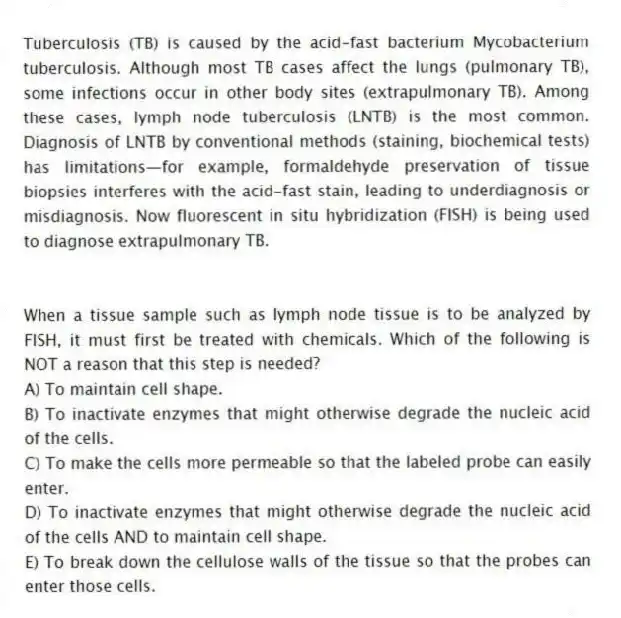
Tuberculosis (TB) is caused by the acid-fast bacterium Mycobacterium tuberculosis. Although most TB cases affect the lungs (pulmonary TB) , some infections occur in other body sites (extrapulmonary TB) . Among these cases, lymph node tuberculosis (LNTB) is the most common. Diagnosis of LNTB by conventional methods (staining, biochemical tests) has limitations—for example, formaldehyde preservation of tissue biopsies interferes with the acid-fast stain, leading to underdiagnosis or misdiagnosis. Now fluorescent in situ hybridization (FISH) is being used to diagnose extrapulmonary TB.
-When a tissue sample such as lymph node tissue is to be analyzed by FISH, it must first be treated with chemicals. Which of the following is NOT a reason that this step is needed?
A) To maintain cell shape.
B) To inactivate enzymes that might otherwise degrade the nucleic acid of the cells.
C) To make the cells more permeable so that the labeled probe can easily enter.
D) To inactivate enzymes that might otherwise degrade the nucleic acid of the cells AND to maintain cell shape.
E) To break down the cellulose walls of the tissue so that the probes can enter those cells.
Correct Answer:
Verified
Q70: The primer used in Sanger (dideoxy chain
Q71: HPV is a DNA virus and can
Q72: It is useful to have a reference
Q73: Sexually transmitted human papillomavirus (HPV) strains are
Q74: During PCR, which primer anneals to template
Q75: Plasmids work well for insertion of foreign
Q76: How are target cells identified using the
Q77: The DNA polymerase used in PCR comes
Q78: PCR generates a DNA fragment of a
Q79: Identify the correct sequence in which the
Unlock this Answer For Free Now!
View this answer and more for free by performing one of the following actions

Scan the QR code to install the App and get 2 free unlocks

Unlock quizzes for free by uploading documents